The global epinephrine market size accounted for USD 3.30 billion in 2025 and is forecasted to hit around USD 6.87 billion by 2034, representing a CAGR of 8.50% from 2025 to 2034. The North America market size was estimated at USD 1.02 billion in 2024 and is expanding at a CAGR of 8.10% during the forecast period. The market sizing and forecasts are revenue-based (USD Million/Billion), with 2024 as the base year.
The global epinephrine market size accounted for USD 3.05 billion in 2024 and is predicted to increase from USD 3.30 billion in 2025 to approximately USD 6.87 billion by 2034, expanding at a CAGR of 8.50% from 2025 to 2034. One of the major factors driving the revenue growth trajectory of the global epinephrine market is the growing incidence of anaphylaxis, primarily in the age group of kids across the globe. For instance, as per the analysis by Pubmed Central, nearly 5% of the U.S. populace has suffered anaphylaxis. Further, prominent players in the epinephrine market are focused on launching cost-effective generic epinephrine products, which in turn are expected to create lucrative revenue growth opportunities in this market.
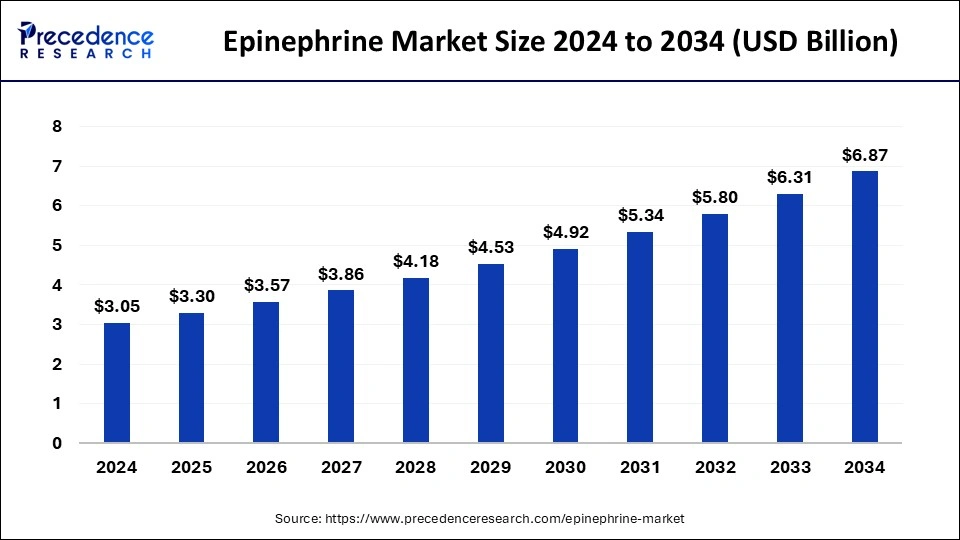
The U.S. epinephrine market size was evaluated at USD 790.7 billion in 2024 and is projected to be worth around USD 1,660.0 billion by 2034, growing at a CAGR of 7.70% from 2025 to 2034.
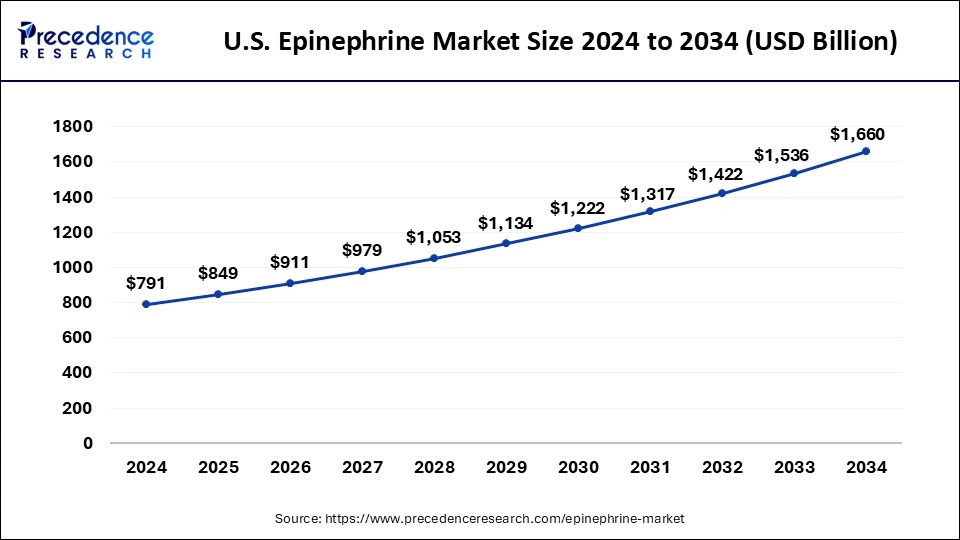
The epinephrine market in North America will likely develop significantly over the following years due to the region's expanding patient population and rising medical science technological advancements. Numerous ongoing research and development initiatives in the U.S. will positively affect the epinephrine industry in the area.
North America acquired the largest revenue share in the year 2024 owing to better research & development programs & initiatives, high-quality healthcare infrastructure, and better reimbursement policies in the region. U.S. is the leading country, followed by Canada, and Mexico. The U.S. has recorded the highest sale in the market in the year. While the region’s primary healthcare emphasis remains on the pandemic as it moves through the 3rd year of its disruptive impacts and the death toll which approached to 1 million, other key dynamics are playing out with respect to health services utilization, the associated level of spending including patient costs out-of-pocket, and the use of prescription medicines. Understanding these factors of the healthcare system and how they may develop over the next few years remains critical to stakeholders and decision-makers including patients.
Furthermore, in order to fulfil the need of epinephrine in Canada, Bausch Health, Canada, which is part of Bausch Health Companies Inc. announced in, that Emerade™ sterile epinephrine solution for injection in a pre-filled pen) will be available across Canada for the emergency treatment of anaphylactic reactions in patients who are determined to be at increased risk for anaphylaxis, including individuals with a history of anaphylactic reactions. Emerade offers the most affordable EAI in Canada for anaphylaxis with the lowest price in the majority of territories and provinces.
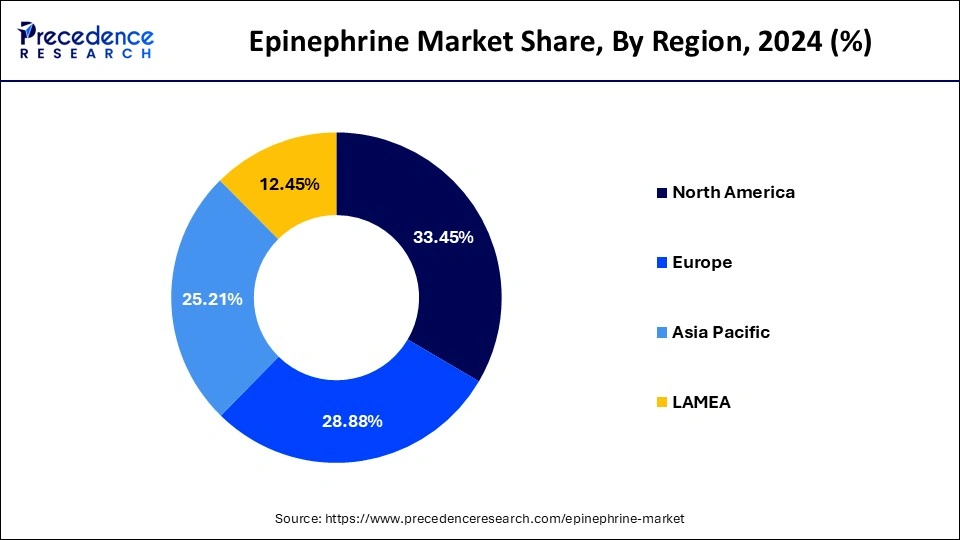
During the forecast period, Asia-Pacific will likely account for a sizable portion of the market. The main drivers of the expansion of the epinephrine business are escalating technology advancement and medical advancement in China, Taiwan, and South Korea. Asia Pacific is expected to grow fastest in the forecast period, owing to better research & development programs & initiatives, high-quality health care infrastructure, and better reimbursement policies in the region. China is the leading country, followed by India, and Japan. Penetration of generic drugs is largest in China, with India being the fastest growing. Health systems across the region are leveraging generic medications increasingly to minimize costs. The rising trend with respect to manufacturing of epinephrine in Asia Pacific is not just the consequence of cost-containment moves by the government, but also since the national governments identify the advantages of having an indigenous manufacturing base locally rather than importing.
Asia Pacific’s significance to pharmaceutical enterprises’ global marketing and product strategies should not be neglected. The aging population locally and expanded government commitment to serve affordable healthcare are determinants facilitating the demand for epinephrine in the region. According to APAAACI 2019, the overall prevalence of food allergy in pre-schoolers was only 1% in Thailand, but as high as 5.3% in Korean infants and 3.8% and 7.7% in one-to two-year-old children in China respectively. Wheat allergy is particularly prominent in Japan, Korea and Thailand. In Japanese school children, wheat allergy is more common than nuts and shellfish and is the main cause of food anaphylaxis in both Japan and Korea. These factors are ought to grow the epinephrine market in the region.
For many years, thousands of people of all ages have benefited from Epinephrine. Because Epinephrine acts as a hormone and medicine, its use has rapidly risen in various contexts. The global epinephrine market is expanding due to the FDA's approval of its usage in several scenarios, including the urgent treatment of type 1 hypersensitivity reactions, maintaining mydriasis during intraocular procedures, and hypertension brought on by septic shock.
The prevalence of outpatient prescriptions, the frequency of anaphylaxis cases, the rise in food allergy cases, the use of Epinephrine during hand surgery, the use of Epinephrine by plastic surgery-trained surgeons, the majority of regulatory agencies and medical professionals authorizing Epinephrine because of its safe usage, the background of training, the location, and the practice setup are the main variables impacting the worldwide epinephrine market.
The use of Epinephrine is increasing quickly in a variety of medical settings due to its advantages, which include the ability to give advanced cardiovascular life support to patients, improved neurologic outcome, rapid absorption, heart stimulation, improved breathing, balanced blood pressure, reduced face swelling, including lips and throat, and first line cure for allergic reactions that are life-threatening. Additionally, the body's response to allergens is slowed down by adrenaline.
Epinephrine is allowed for use, although there are potential side effects linked with it. Additionally, recent research has demonstrated that Epinephrine may negatively affect the central nervous system, gastrointestinal tract, neuromuscular system, respiratory system, renal system, cardiovascular system, and neuromuscular system. According to researchers, Epinephrine is a significant cause of adverse effects on critical bodily components and results in medication interactions. Regulatory agencies have generally disregarded Epinephrine as a crucial agent in operating room (OR) settings, particularly for the local anesthetic block. Despite its intended utility, studies have shown that Epinephrine can adversely affect humans and the environment, significantly impacting the market situation.
Other barriers to the growth of the global epinephrine market include the high cost of auto-injectors and the limited availability of reimbursement in underdeveloped countries.
| Report Coverage | Details |
| Market Size in 2025 | USD 3.30 Billion |
| Market Size by 2034 | USD 6.87 Billion |
| Growth Rate from 2025 to 2034 | CAGR of 8.50% |
| Base Year | 2024 |
| Forecast Period | 20245 to 2034 |
| Largest Market | North America |
| Fastest Growing Market | Asia Pacific |
| Segments Covered | By Type, By Application, and By Distribution Channel |
| Regions Covered | North America, Europe, Asia-Pacific, Latin America, and Middle East & Africa |
The forecast term will likely see a significant CAGR for the global epinephrine market. The pharmaceutical industry will probably expand, along with other factors such as the rise in the number of patients susceptible to different allergies, improvements in production, and an increase in the prevalence of various chronic diseases, which will all contribute to the growth of the epinephrine market.
The market will likely grow as more people develop allergies to dust, bug bites, venom, and food additives. Innovations and improvements in the pharmaceutical industry are significantly impacting the epinephrine market. The medulla of the adrenal gland releases Epinephrine, often known as adrenaline.
The global epinephrine market can be divided into auto-injectors, prefilled syringes, and ampoules & vials. Autoinjectors held the largest share of around 77.68% in 2024 and are expected to hold a substantial share in the coming years. The autoinjector is a prescription medicine that is used to treat Anaphylaxis symptoms. Epinephrine Autoinjectors may be used with other medications or can also be used alone. It is indicated in the emergency treatment of allergic reactions (Type I) like anaphylaxis to stinging insects (like, order Hymenoptera, which includes wasps, hornets, bees, fire ants and yellow jackets), and biting insects (like, mosquitoes, triatoma), allergen immunotherapy, drugs, foods, diagnostic testing substances (like, radiocontrast media), and other allergens, as well as exercise-induced anaphylaxis or idiopathic anaphylaxis.
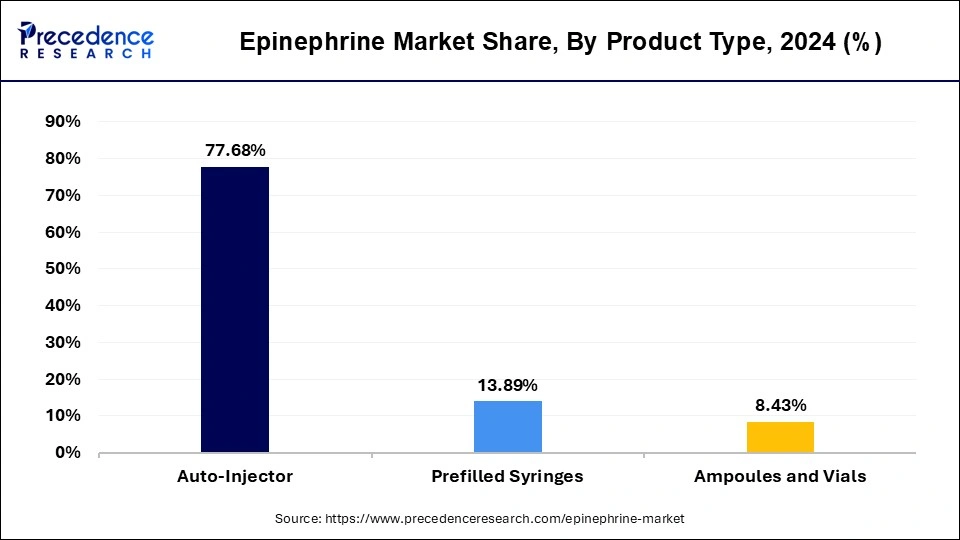
The prefilled syringes segment is expected to grow the fastest in the coming years. Prefilled syringes offer a convenient way to administer epinephrine to patients experiencing cardiac arrest. In some countries, adrenaline is available only in glass ampoules. However, simplification of cardiopulmonary resuscitation (CPR) by introducing prefilled syringes may ensure more efficient CPR. The aim of this study was to investigate the impact of different forms of adrenaline on CPR quality.
The global epinephrine market can be divided into several categories depending on the use, including anaphylaxis and cardiac arrest. Maximizing blood flow through the coronary artery is crucial during cardiac arrest. Epinephrine elevates coronary artery pressure by being administered into an intravenous fluid solution, which encourages enhanced coronary blood flow. Increased epinephrine dosages can occasionally speed up the reaction, but some studies have shown that they can also cause damage to the brain and the heart. A dangerous and potentially fatal allergic reaction is anaphylaxis.
The most frequent causes of anaphylactic responses are meals, drugs, latex, insect bites, and medications. If a person has an allergy to something, their immune system will respond to the allergen by secreting molecules resulting in allergy symptoms. The blood flow throughout the body boosts when Epinephrine injects into the bloodstream. Due to the short half-life of adrenaline, the relief is only transient, so the patient must be hospitalized immediately to safeguard their safety.
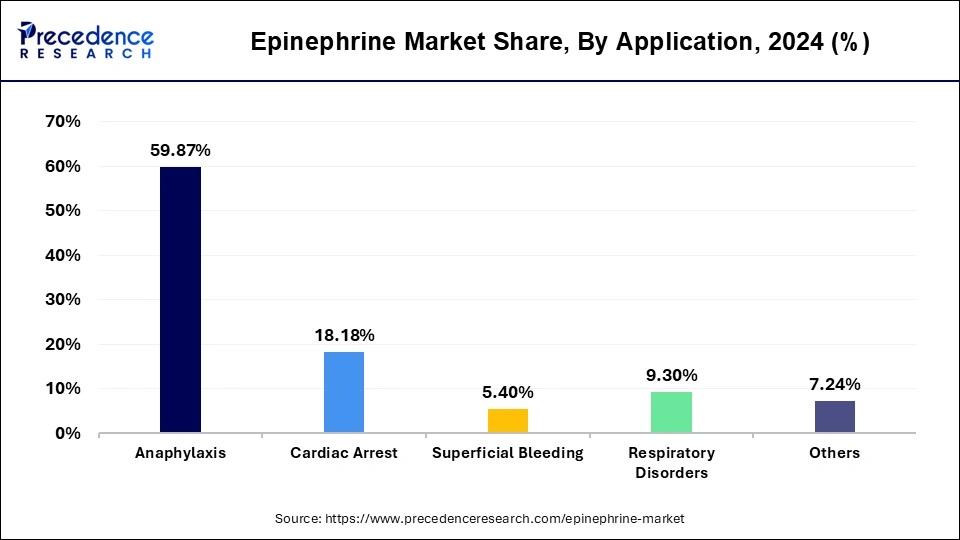
Anaphylaxis held the largest share in the application segment. Anaphylaxis is severe, type I hypersensitivity allergic reaction to food, drug, or insect venom. This results in a sudden drop in blood pressure, narrowing of airways, and shortness of breath and may further lead a patient to go into a shock called anaphylactic shock. Symptoms of anaphylaxis include a rapid weak pulse, skin rashes, nausea and vomiting.
Epinephrine is the first and most prominent treatment for anaphylaxis. It should be administered as soon as anaphylaxis is recognized to prevent further severe damage to the patient. Once a patient is diagnosed with anaphylaxis, the doctor will recommend the patient to carry epinephrine all the time. This phenomenon further creates great opportunities for manufacturers in the epinephrine market. Furthermore, as respiratory arrest associated with anaphylaxis can lead to a patient’s death within minutes, prompt assessment and treatment are vital in anaphylaxis. This can be made easier with the accurate use of epinephrine. This factor is further expected to drive the epinephrine market. In addition to this, the use of epinephrine is considered to be safe in the pediatric population with very low rates of side effects, which further drives this segment in the epinephrine market.
Technological advancements like epinephrine pens or automated devices for the treatment of anaphylactic shocks are key trends in the epinephrine market.
Cardiac arrest is expected to grow fastest in the forecast period. Cardiac arrest is associated with the sudden loss of heart function, breathing and unconsciousness. It usually disturbs the heart’s pumping action and stops blood flow to the body including the brain and lungs. If not treated immediately, cardiac arrest can lead to death within minutes.
Cardiopulmonary resuscitation (CPR) is an emergency procedure followed when cardiac arrest is recognized. Epinephrine is a primary drug administered in CPR to reverse the effects of cardiac arrest. During cardiac arrest, epinephrine is administered as a continuous infusion to reduce the risk associated with the blood flow.
Epinephrine, being the only drug used during CPR, dominates the segment and thereby drives the growth of the epinephrine market. In addition to this, the use of epinephrine being a promising first-line treatment for cardiac arrest prevents the patient from sudden death. This factor further drives the growth of the epinephrine market. Sudden cardiac arrest (SCA) affects from 350,000 to 700,000 people per year in Europe and over 380,000 in the United States. The use of automated external defibrillators for emergency first-line treatment of cardiac arrest is a key trend.
Epinephrine Market Revenue, By Application, 2022-2024 (USD Billion)
| By Application | 2022 | 2023 | 2024 |
| Anaphylaxis | 1,571.5 | 1,693.7 | 1,826.8 |
| Cardiac Arrest | 469.7 | 510.3 | 554.8 |
| Superficial Bleeding | 143.3 | 153.7 | 164.9 |
| Respiratory Disorders | 242.1 | 262.0 | 283.7 |
| Others | 193.0 | 206.5 | 221.0 |
Hospital pharmacies are anticipated to witness significant growth in the epinephrine market over the forecast period. Conditions like superficial bleeding are associated with post-operative procedures in plastic or reconstructive surgeries. Such surgeries significantly occur inside hospitals. Hence superficial bleeding segment is expected to propel the growth of hospital pharmacies.
In addition to this, doctors prescribe and recommend keeping epinephrine injections along with them all the time for patients who face anaphylactic shocks. This factor is further expected to propel the growth of the hospital pharmacies segment.
Retail pharmacies held the largest share in the distribution channel segment. Retail pharmacies are expected to hold a considerably high revenue share over the forecast period. Sudden reactions like anaphylactic shocks and cardiac arrest occur more often outside the hospital. And such reactions need to be treated as soon as they appear. Hence patients are anticipated to avail of epinephrine products from retail pharmacies in emergency situations. This further dominates the retail pharmacies segment and drives the growth of the global epinephrine markets. In addition to this, an increase in demand for epinephrine pens and automated external defibrillators is anticipated to further drive the growth of this segment.
Furthermore, in the case of respiratory disorders such as asthma, doctors recommend using epinephrine inhalation aerosol which is an over-the-counter product. Patients prefer purchasing over-the-counter products from retail pharmacies. This factor is further expected to propel the growth of this segment.
The online pharmacies segment is expected to grow the fastest over the forecast period. With the growing penetration of the internet and the availability of smartphones, e-commerce has witnessed exceptional growth across various categories from apparel to medicines, people have started buying most of their requirements through online platforms. The global online pharmacy market was estimated at around USD 0.72 Billion in the year 2020, in which prescription medicines occupied 27.52% revenue share. Online pharmacies are adopting cost-effective strategies and different schemes by reducing distribution channel interventions. And thereby, delivering epinephrine products to customers doorstep at a reduced cost.
Customers of the overall $460 billion retail pharmacy sector are increasingly demanding a pharmacy experience that mirrors the rest of their retail experiences omnichannel, convenient, and with home delivery at the center. In addition to this, online pharmacies are expected to pose potential powerful opportunities to boost sales in the epinephrine market. Furthermore, they are anticipated to increase market share and generate new business by offering new services to customers.
Epinephrine Market, By Distribution Channel, 2022-2024 (USD Billion)
| By Distribution Channel | 2022 | 2023 | 2024 |
| Hospital Pharmacies | 815.9 | 877.6 | 944.7 |
| Retail Pharmacies | 1,082.6 | 1,160.9 | 1,245.9 |
| Online Pharmacies | 721.0 | 787.5 | 860.6 |
By Product Type
By Application
By Distribution Channel
By Geography
For inquiries regarding discounts, bulk purchases, or customization requests, please contact us at sales@precedenceresearch.com
No cookie-cutter, only authentic analysis – take the 1st step to become a Precedence Research client